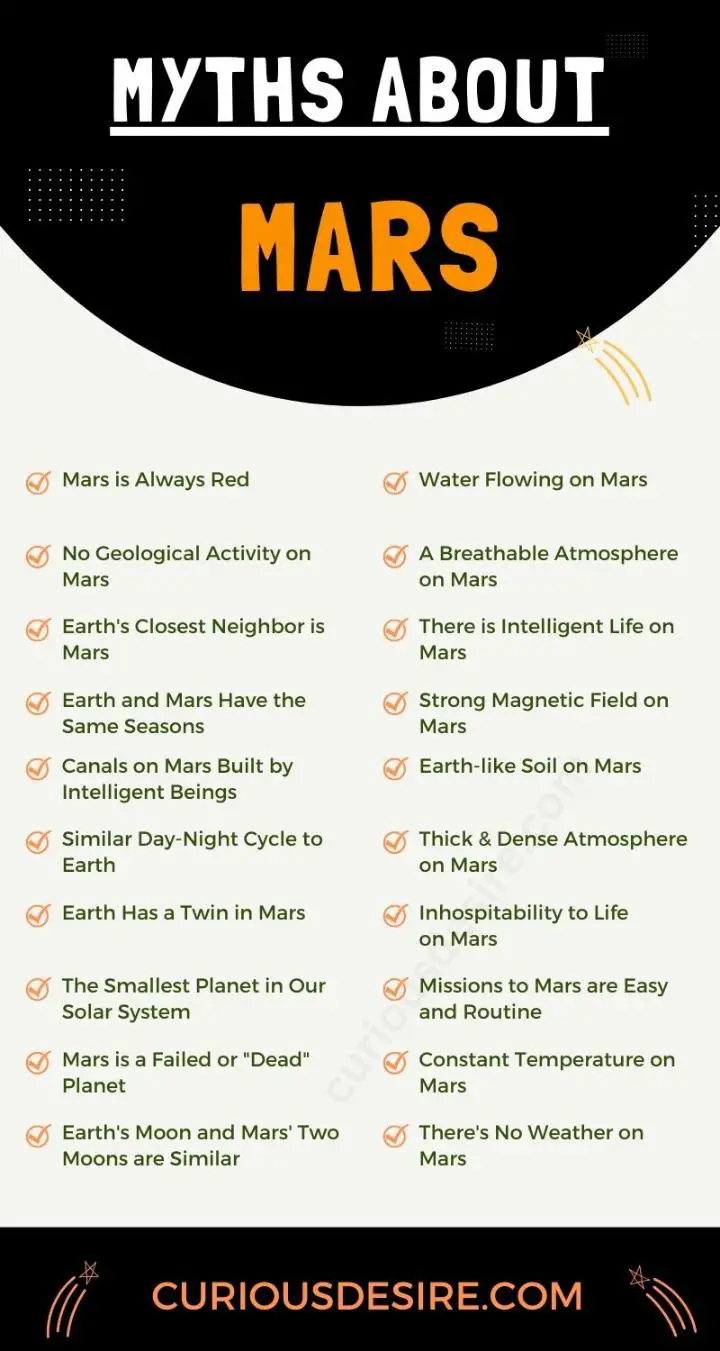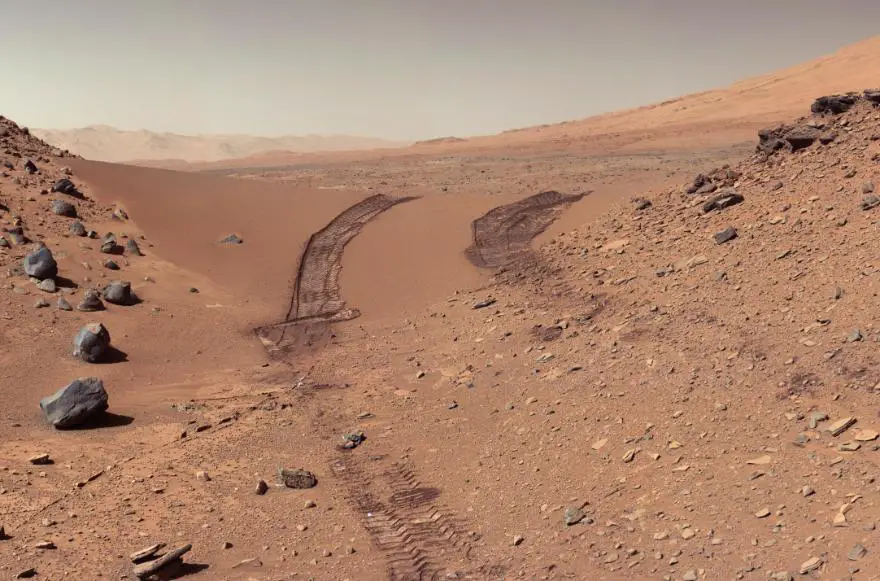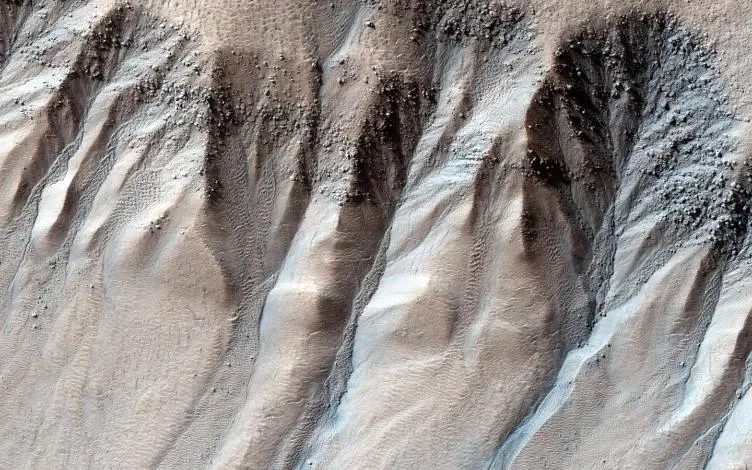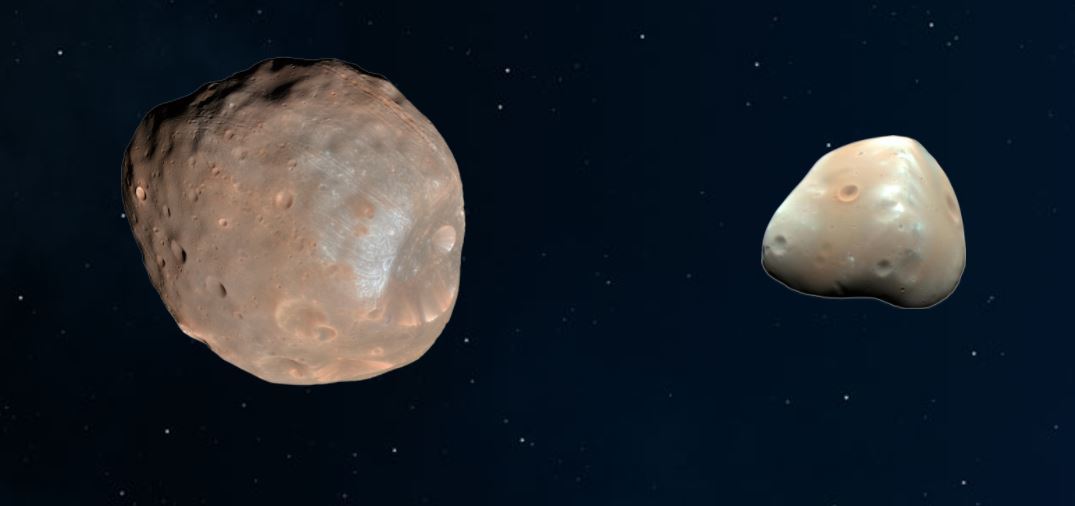Mars, the Red Planet, has gathered its fair share of misunderstandings over the years. From its distinctive color to rumors of possible life, various myths have emerged.
In this article, we’ll set the record straight and uncover the truth behind common myths about Mars.
5 Common Myths About Mars:
- Mars is Always Red
- There is Water Flowing on the Surface of Mars
- Earth’s Closest Neighbor is Mars
- There’s No Weather on Mars
- Missions to Mars are Easy and Routine
[toc]

Myth 1: Mars is Always Red
Why Does This Myth Exist?
People call Mars the “Red Planet,” so it’s easy to imagine it always looks red. Pictures from rovers and telescopes often show it as a rusty red color, reinforcing this idea.
The nickname “Red Planet” creates a lasting impression, and the association with the color red is deeply embedded in popular culture.
Debunking the Myth:
Yes, Mars has a reddish color because of rust, specifically iron oxide, on its surface. But it’s not always the same shade of red. The color changes depending on things like the time of day and dust storms.
During sunrise and sunset, it looks pink or brown. Dust storms can make it even harder to predict the exact color.
So, while Mars is indeed red, it’s not stuck that way. It has its own changing colors, influenced by factors like sunlight and dust.
Myth 2: There is Water Flowing on the Surface of Mars
Why Does This Myth Exist?
Historical observations of apparent water channels and the discovery of water ice contribute to the misconception that liquid water flows freely on Mars.
Discoveries of water ice in polar regions and evidence of past liquid water add to the allure of this myth. The desire to find signs of life, possibly sustained by liquid water, also keeps the belief alive.
Debunking the Myth:
There is ice on Mars, like frozen water, but finding regular rivers or lakes is tricky because it has a low-pressure atmosphere.
Sometimes, scientists see tiny bits of salty water coming out, but it’s more like little leaks than flowing rivers.
Most of Mars’ water is probably stuck in ice at the poles or hidden under the ground. So, while there’s some ice on Mars, it’s not like Earth with lots of flowing water everywhere.
Myth 3: There Is No Geological Activity on Mars
Why Does This Myth Exist?
There is a lack of evident signs of geological activity that Earth possesses on Mars, contributing to the perception of a “dead” planet.
The public often associates geological activity with visible features like volcanoes and earthquakes, which are less apparent on Mars.
Debunking the Myth:
The truth is that there are geological activities on Mars, although on a different scale.
Evidence of past volcanic activity, such as Olympus Mons (the largest volcano in the solar system) and Valles Marineris (a vast canyon), attests to Mars’ dynamic geological history.
While not as active as Earth, Mars also undergoes processes like erosion, sedimentation, and seismic activity.
Myth 4: A Breathable Atmosphere on Mars
Why Does This Myth Exist?
The idea of an atmosphere existing on another planet may lead to assumptions that it is similar to Earth’s.
Images of Mars’ surface taken by rovers may not convey the thinness of the atmosphere, contributing to the misconception.
Debunking the Myth:
The atmosphere of Mars is primarily carbon dioxide with trace elements, but it lacks the oxygen levels essential for human survival.
Breathing there would require life support systems, as the atmosphere is incapable of sustaining human life without significant modifications.
Myth 5: Earth’s Closest Neighbor is Mars
Why Does This Myth Exist?
Mars’ proximity during its opposition, a period when it’s closest to Earth, might mislead some into thinking it’s consistently the nearest planet.
During opposition, it can come relatively close to Earth, creating the impression that it is always the nearest planet. The concept of “closest” is often simplified, leading to the assumption that Mars maintains this proximity consistently.
Debunking the Myth:
While the Red Planet can come relatively close to Earth during opposition, its distance varies as both planets follow elliptical orbits.
At other times, Venus or Mercury may be closer, depending on their positions in their orbits. The concept of “closest” is dynamic in the context of planetary orbits.
Myth 6: There is Intelligent Life on Mars
Why Does This Myth Exist?
Historical observations, such as those by Percival Lowell, also led to the idea of artificial structures on Mars, sparking excitement about potential intelligent beings.
The search for extraterrestrial life keeps this myth alive despite the lack of concrete evidence.
Debunking the Myth:
Even though we’ve sent many missions to Mars, we haven’t found any real proof that there are smart aliens living there.
The way Mars is – with its rough surface, not having many complicated tiny building blocks of life, and being a pretty tough place to survive – it seems really unlikely that there are aliens there now or that there were in the past.
Myth 7: Earth and Mars Have the Same Seasons
Why Does This Myth Exist?
The axial tilt and the length of Mars’ year being roughly twice that of Earth may create the impression that the seasons align similarly.
Visualizing the changing seasons on another planet can be challenging without considering these differences.
Debunking the Myth:
Due to its longer orbit, Mars experiences seasons nearly twice as long as Earth’s. The thin atmosphere also contributes to milder temperature variations compared to Earth.
To understand the seasons on Mars, it’s essential to consider these variations in orbit and atmospheric conditions.
These factors contribute to the unique and extended seasonal patterns on the Red Planet, making the study of Martian seasons a fascinating aspect of planetary science.
Myth 8: Strong Magnetic Field on Mars
Why Does This Myth Exist?
The assumption that terrestrial planets should have a strong magnetic field, like Earth, contributes to the persistence of this myth.
Comparisons with Earth’s features often lead to misunderstandings about the nature of Mars’ magnetic field.
Debunking the Myth:
The magnetic field of Mars is weak and patchy compared to Earth’s robust shield.
The lack of a global magnetic field contributes to its thin atmosphere being stripped away over time by solar wind, impacting its overall climate.
Myth 9: There are Canals on Mars Built by Intelligent Beings
Why Does This Myth Exist?
In the 1800s, when people looked at Mars using telescopes, some thought they saw straight lines that seemed like artificial canals.
This led to ideas and stories about Martians building these canals. People got really excited and started imagining advanced civilizations on Mars.
Debunking the Myth:
New and improved telescopes, along with spacecraft pictures, have shown that those ‘canals’ on Mars are not really there. There’s no evidence supporting the existence of artificial structures on Mars.
What’s really happening is that Mars has natural features like hills and holes caused by big rocks hitting it a long time ago.
So, no alien cities – just regular Mars being all rocky and interesting
Myth 10: Earth-like Soil on Mars
Why Does This Myth Exist?
The visible presence of iron oxide, similar to rust, contributes to the perception that Mars’ soil is akin to Earth’s. The desire to find familiar elements on Mars may lead to overlooking the significant differences in soil composition.
Debunking the Myth:
The soil of Mars, known as regolith, differs significantly from Earth’s. It lacks essential nutrients and microbial life that contribute to Earth’s fertile soil.
The regolith is also chemically reactive, containing perchlorates, making it inhospitable for terrestrial plant growth without extensive modification.

Myth 11: Mars has a Similar Day-Night Cycle to Earth
Why Does This Myth Exist?
Mars’ day is close to 24.6 hours, not far off from Earth’s 24-hour day, leading to assumptions of a similar day-night cycle.
However, factors like axial tilt and orbit differences influence the Martian cycle.
Debunking the Myth:
While the day length is comparable, Mars’ axial tilt and elliptical orbit result in variations in day length and seasonal changes.
Understanding the Martian day-night cycle requires accounting for these differences, making it distinct from Earth’s regular cycle.
Myth 12: Thick and Dense Atmosphere on Mars
Why Does This Myth Exist?
Assumptions about Mars’ atmosphere may stem from its hazy appearance in some images, leading to the belief that it’s dense.
Debunking the Myth:
The atmosphere of Mars is about 100 times thinner than Earth’s, creating challenges for aerodynamic flight and limiting its ability to retain heat.
The thin atmosphere contributes to the extreme temperature fluctuations experienced on the Martian surface.
Myth 13: Earth Has a Twin in Mars
Why Does This Myth Exist?
The visual similarities between Earth and Mars, especially when observing polar ice caps and surface features, may contribute to the belief that they are nearly identical.
Overlooking the significant differences plays a role in the persistence of this myth.
Debunking the Myth:
While there are similarities, Mars lacks key components essential for Earth-like conditions, such as a thick atmosphere and a magnetosphere.
Understanding this planet requires recognizing both its shared characteristics and significant differences.
Myth 14: Complete Inhospitability to Life on Mars
Why Does This Myth Exist?
Harsh surface conditions and a thin atmosphere may lead some to believe that no form of life could exist on Mars.
Misunderstandings about the potential for life in extreme environments may play a role.
Debunking the Myth:
While surface conditions are challenging, the possibility of microbial life existing in the subsurface or in protected niches is still a subject of scientific exploration.
Recent discoveries of organic molecules and liquid water beneath the surface suggest the potential for microbial habitats on Mars.
Myth 15: The Smallest Planet in Our Solar System is Mars
Why Does This Myth Exist?
The visual comparison of Mars with the gas giants, like Jupiter and Saturn, may lead to the misconception that Mars is one of the smaller planets in the solar system.
The focus on its rocky composition, similar to Earth’s, reinforces this perception.
Debunking the Myth:
Mars is larger than Mercury and only slightly smaller than Earth. While smaller than the gas giants, its size is significant enough to influence its geological processes and atmosphere.
Understanding Mars’ size within the context of the solar system is crucial for appreciating its unique characteristics.
Myth 16: Missions to Mars are Easy and Routine
Why Does This Myth Exist?
The successful execution of Mars missions, especially with the increasing frequency of robotic explorers, may create the impression that these missions are routine.
The public may underestimate the complexity and challenges involved.
Debunking the Myth:
Missions on Mars are incredibly complex and challenging. Factors like distance, communication delays, and the need for autonomous systems make its exploration a feat that requires meticulous planning and advanced technology.
The success of such missions is a testament to human ingenuity and perseverance.
Myth 17: Mars is a Failed or “Dead” Planet
The visual representation of a barren Martian landscape, devoid of vibrant ecosystems, contributes to the belief that Mars is a failed or “dead” planet. Surface conditions may be misinterpreted as a lack of ongoing processes.
Debunking the Myth:
While Mars’ surface conditions are inhospitable, evidence of past geological and potentially even microbial activity suggests a dynamic history.
Understanding Mars as a planet that has undergone changes over billions of years is crucial for unraveling its mysteries.
Myth 18: Constant Temperature on Mars
Why Does This Myth Exist?
The perception that Mars, being farther from the sun, should have a consistent and unchanging temperature contributes to this myth.
Oversimplifications about planetary temperatures may play a role.
Debunking the Myth:
There are significant temperature variations on Mars due to its thin atmosphere. Daytime temperatures can reach above freezing, while nighttime temperatures plummet, creating extreme temperature differentials.
The lack of a thick atmosphere contributes to these fluctuations.
Myth 19: Earth’s Moon and Mars’ Two Moons are Similar
Why Does This Myth Exist?
The common association of planets with moons may lead to the assumption that Martian moons are similar to Earth’s moon. Oversimplifications about the nature of moons around planets contribute to this misconception.
Debunking the Myth:
Phobos and Deimos, Mars’ moons, are irregularly shaped and much smaller than Earth’s moon. They likely originated from the asteroid belt and have distinct properties.
Understanding the differences between Mars’ moons and Earth’s moon is essential for comprehending their formation and role in the Martian system.
Myth 20: There’s No Weather on Mars
Why Does This Myth Exist?
The arid and seemingly desolate landscape of Mars, combined with limited observations of weather phenomena, may lead to the misconception that it has a static climate.
The lack of immediate visual cues for weather, as seen on Earth, contributes to this myth.
Debunking the Myth:
This planet experiences a variety of weather phenomena, including dust storms, clouds, and seasonal changes. Dust storms can envelop the entire planet, affecting visibility and surface temperatures.
Understanding Martian weather patterns is crucial for planning missions and comprehending the planet’s atmospheric dynamics.
Mars Myths FAQs
What are 5 interesting facts about Mars?
- Mars is often called the “Red Planet” due to its rusty appearance.
- It has the largest volcano and canyon in the solar system: Olympus Mons and Valles Marineris.
- Mars has polar ice caps made of water and carbon dioxide.
- A day on Mars is approximately 24.6 hours long.
- Mars has a thin atmosphere composed mostly of carbon dioxide.
What is the story behind Mars?
Named after the Roman god of war, Mars has captivated human imagination as a symbol of conflict and potential habitability.
What is the mythological origin of Mars?
In Roman mythology, Mars was the god of war, the son of Jupiter and Juno. He was also associated with agriculture.
Why is Mars so special?
Mars is special due to its potential as a future human settlement, its unique geological features, and its role in scientific exploration.
What is unique about Mars?
Mars has the tallest volcano and the longest canyon, a day length similar to Earth, and evidence of liquid water in its past.
Is there life on Mars facts?
No direct evidence of current life on Mars has been found. Scientists are exploring the possibility of past microbial life.
Is Mars hot or cold?
Mars is generally cold, with an average surface temperature of around minus 80 degrees Fahrenheit (minus 62 degrees Celsius).
Can Mars hold life?
Mars is being explored for signs of past or present microbial life, but current conditions are harsh for most forms of life.
Can Mars have human life?
Future human colonization of Mars is a topic of research and exploration, but it presents numerous challenges.
Which planet has oxygen?
Earth is the only planet known to have a significant amount of free oxygen in its atmosphere.

